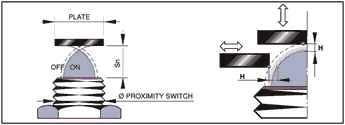- 5mm U-shaped photoelectric sensor
- New Metallic label capacitive Fork Label sensor S-4200
- Regarding label sensors
- Ultrasonic Sensor Theory and application
- Regarding Fiber Optical Sensor
- What is a Photoelectric Sensor
- Sticker labeling machine for bottle beer application
- Metallic label sensors s-4200 series
- Operating principles for capacitive sensor
- Operating principles for photoelectric sensors
- E-mail: samuel#sunland-auto.com
- Please change # to @
- WeChat: s-sensors
- Skype: +86 18688621237
Inductive proximity sensors are used for non-contact detection of metallic objects. Their operating principle is based on a coil and oscillator that creates an electromagnetic field in the close surroundings of the sensing surface. The presence of a metallic object (actuator) in the operating area causes a dampening of the oscillation amplitude. The rise or fall of such oscillation is identified by a threshold circuit that changes the output of the sensor. The operating distance of the sensor depends on the actuator's shape and size and is strictly linked to the nature of the material (Table 1).

Table (1)
| Table 1. Sensitivity when different metals are present. Sn = operating distance. | |
| Fe37 (Iron) | 1 x Sn |
| Stainless steel | 0.9 x Sn |
| Brass - Bronze | 0.5 x Sn |
| Aluminum | 0.4 x Sn |
| Copper | 0.4 x Sn |
Definitions:
NO (normally open): A switch output that is open prohibiting current flow when an actuator is not present and closes allowing current flow when an actuator is present.
NC (normally closed): A switch output that is closed allowing current flow when no actuator is present and opens prohibiting current flow when an actuator is present.
NPN Output: Transistor output that switches the common or negative voltage to the load. The load is connected between the positive supply and the output. Current flows from the load through the output to ground when the switch output is on. Also known as current sinking or negative switching.
PNP Output: Transistor output that switches the positive voltage to the load. The load is connected between output and common. Current flows from the device's output, through the load to ground when the switch output is on. Also known as current sourcing or positive switching.
Operating Distance (Sn): The maximum distance from the sensor to a square piece of Iron (Fe 37), 1mm thick with side's = to the diameter of the sensing face, that will trigger a change in the output of the sensor. Distance will decrease for other materials and shapes. Tests are performed at 20ºC with a constant voltage supply. This distance does include a ± 10% manufacturing tolerance.
Power Supply: The supply voltage range that sensor will operate at.
Max Switching Current: The amount of continuous current allowed to flow through the sensor without causing damage to the sensor. It is given as a maximum value.
Min Switching Current: It is the minimum current value, which should flow through the sensor in order to guarantee operation.
Max Peak Current: The Max peak current indicates the maximum current value that the sensor can bear in a limited period of time.
Residual Current: The current, which flows through the sensor when it is in the open state.
Power Drain: The amount of current required to operate a sensor.
Voltage Drop: The voltage drop across a sensor when driving the maximum load.
Short Circuit Protection: Protection against damage to a sensor if the load becomes shorted.
Operating Frequency: The maximum number of on/off cycles that the device is capable of in one second. According to EN 50010, this parameter is measured by the dynamic method shown in fig. 1 with the sensor in position (a) and (b). S is the operating distance and m is the diameter of the sensor. The frequency is given by the formula in fig. 2.
Repeatability (%Sn): The variation between any values of operating distance measured in an 8 hour period at a temperature between is 15 to 30ºC and a supply voltage with a <= 5% deviation.
Hysteresis (%Sn): The distance between the "switching on" point of the actuator approach and the "switching off" point of the actuator retreat. This distance reduces false triggering. Its value is given as a percent of the operating distance or a distance. See Fig. 3
Flush Mounting: For side by side mounting of flush mount models refer to Fig. 4a. Non-flush mount models can be embedded in metal according to Fig. 4b. for side by side refer to fig. 4c. Sn = operating distance.
Protection Degree: Enclosure degree of protection according to IEC (International Electrotechnical Commission) is as follows:
IP 65: Dust tight. Protection against water jets.
IP 67: Dust tight. Protection against the effects of immersion
- Home - About us - New products - News - Download - FAQ - Feedback - Contact us - Sitemap
- All rights received by s-sensors
 |
 |
 |
| Add Wechat as contact | Add WhatsAPP as contact | Add Skype as contact |





 2017-6-26
2017-6-26